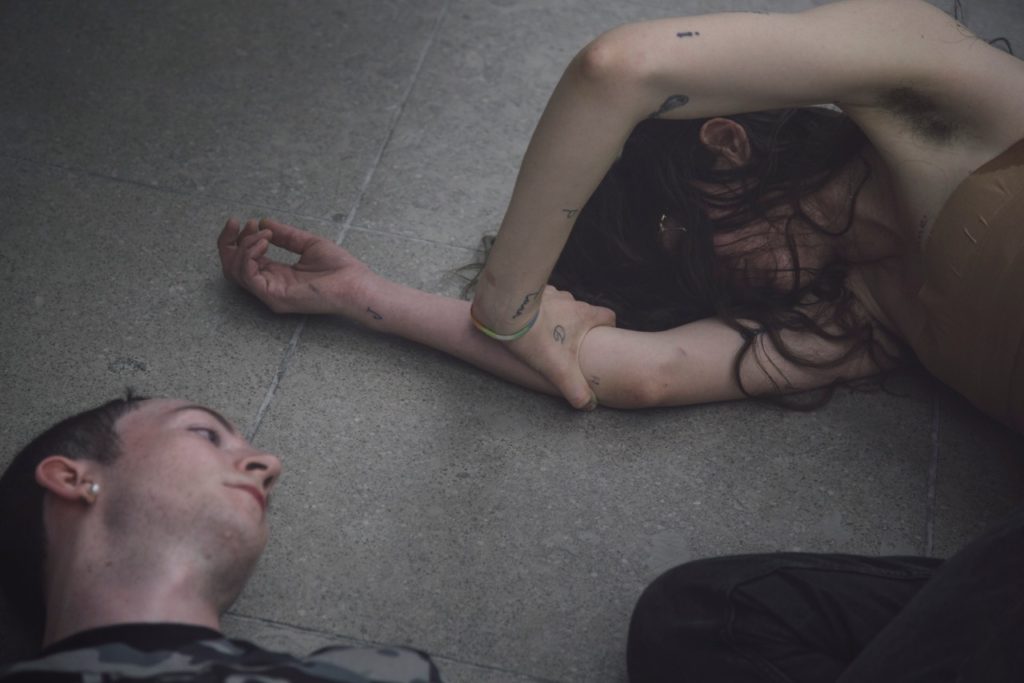Anne Imhof the artist emerged in the libidinal shadows of the European financial project in Frankfurt. Before entering the city’s famed Städelschule art academy, her first improvised work happened in its red light district — a boxing match in a strip club. A band played. Noses were bloodied and broken.

Barely a decade later, the news that Giessen-born Imhof would be representing Germany at the 2017 Venice Biennale initially divided critics — from different corners she was claimed too young, too queer or too fascist. The artist responded with a proposition, equal parts provocative and epic: a seven-month long choreographed scenario encompassing the whole German pavilion, with sculptural and painterly interventions, and daily five-hour performances for the duration of the show, called Faust.
The architectural history of the building has long proved challenging for exhibiting artists. Replete with square columns, it was designed by Ernst Haiger in 1938 under the Nazi regime. Imhof encloses the kitsch palatial structure with temporary steel security gates. A couple of Doberman Pinschers are being calmed down by their handler, a muzzled aggression that foreshadows the action inside.
As well as being the German word for ‘fist,’ the title is borrowed from Goethe’s restless protagonist who sells his soul to the devil, later inspiring the overture by 19th century composer Richard Wagner, whom Adolf Hitler famously admired. Can the latent allusions to fascism implicit within Imhof’s work maintain criticality, or do they encourage a dark public fascination with the totalitarian theatrics of power?
Within Haiger’s original knave-like interior, the artist has constructed a platform in toughened glass, a material motif of an investment bank. This architectural mise-en-abyme — sharp transparent geometries set within an austere neoclassical interior — offers a disturbing read of contemporary Germany. The nation’s dominance within today’s neoliberal framework was itself born from the uterine shell of an autocratic regime.
Around the space is a considered disarray of ambivalent objects — tubes, an electric guitar, concrete sinks, sodden towels — that evoke Imhof’s personal history working as a bouncer at Frankfurt’s legendary nightclub Robert Johnson. It’s the world of nocturnal violence with the lights turned on. Performers move languidly but with precision. Hands are on throats, tenderness contorts into aggression; simple gestures of walking are slowed down, glances become gazes. The dynamics of control pervade these actions. The micro-movements demonstrate how organic beings buckle under abstract powers and systems, evoking the current political tensions as right-wing ideologies start to take hold.
At one point, a group of slender, pale individuals huddle into a group, crouching under the transparent floor as if in a post-apocalyptic cell, lighting fires that generate drips of condensation on the glass above. At another, they mime their own sound-designed voices, individual tracks that coalesce into pop choral harmony. The atmosphere is oppressive in the most compelling of ways. The critique of capitalist acceleration and its ensuing alienation is embodied relationally — visceral but lifeless — like the neoliberal project that promises self-actualisation but instead delivers disaffection. Creating dark equivalences between clubbing, finance, fashion, and art, Imhof has a clear preoccupation with constellations of power, and a vocabulary with which to examine it. As her already rapid rise continues, the opportunities to explore this will undoubtedly multiply and grow exponentially in scale.
The gestural lexicon Imhof draws from is a universal of violence and alienation. These motions could be performed by any trained dancer, however they are not. Of late, there has been a specific directionality to Imhof’s casting. Many work as professional models occupying the Vetements-Balenciaga nexus in fashion circuits. And they are dressed accordingly, with slouched, oversized hoodies, ‘atheleisure’ track shorts. Curator Susanne Pfeffer describes Imhof’s troupe as “post-gender, individualized, peculiar and yet stereotypical.” Her performers hover between subjecthood and objecthood — somehow undead but with a beauty constructed in the zeitgeist. The motivations for Imhof’s employment of such figures becomes problematic within today’s hypervisualised image economy, where it is now near-obligatory for artists to generate documentation that can be shared over social networks. Once still, square-framed and flattened, Imhof’s work becomes void of critical urgency — slick and composed, seductive and infinitely Instagram-able.
The presence and the image of Imhof’s work seem diametrically opposed. The pictures render aspirational the very condition the performances seem to critique. Elements that seem peripheral when viewed spatially take on a different aspect when captured photographically — the visual signifiers, the colours, the casting become means to generate traction and followers, as if optimised for digital consumption and dissemination. A twisted economy emerges between the real and the representation. Perhaps these seductive images serve as a sort of Trojan horse that deviously expands the scale of Imhof’s audience — a cult of undead, hyperconnected youth completely immersed in neoliberalism — giving the artist further material for critique to generate future performative work. Imhof may be acting like a canny banker constructing a derivative financial product to generate future profits.
Even if her intentions were revealed, it’s a gamble that seems risky — today’s technological infrastructure creates asymmetries in the market of meaning. A performance can be only experienced in an instant, its agency is confined. An image is infinitely more shareable and stored forever. Today, these representations are disambiguated by machines, their ambivalence exchanged for virality. This affects how an artist like Imhof’s oeuvre is remembered — the violent complexities in the work simplified and commoditizable.
The artist’s success is simply a symptom of a wider phenomenon. Despite its flirtations with elements of a divisive German history, it is not Anne Imhof’s work in itself that contains fascism. Rather, the grains of totalitarianism are held in the infrastructural optics of contemporary art born in Silicon Valley, where the flattened image takes primacy over experience, and the digital subsumes the vital.**














